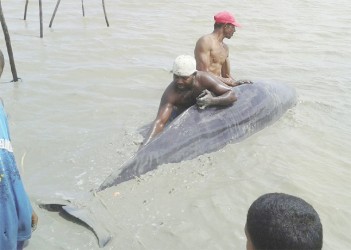A whale, measuring between 10 and 12 feet, was found early yesterday morning entangled in a fisherman’s seine at No.37 Village, West Coast Berbice and died during attempts to return it to the ocean.
Dr Calvin Bernard, who heads the Biology Department at the University of Guyana, told Stabroek News that authorities would be working to de-flesh the bones and bury the whale.
He also said they are working to determine the species as well as the cause of death, which could be known by today.
The discovery of the whale came less than a month after a dead sperm whale washed up on the mudflat of the Kitty seawall.

The dead 45-foot sperm whale, estimated to be about 35 tonnes, was believed to have traveled from Mahaicony, Berbice—a few kilometers from where the whale was found yesterday.
The occurrence of whales washing up on the foreshore along the coast has led some conservationists to believe that there is some sort of seismic activity or current sending the mammals off-course. According to Vanessa Benn, of the Iwokrama International Centre, the relevant authorities would have to investigate what is sending the whales off-course.
The whale was discovered by a fisherman Stanley D’Aguiar while he was picking up his seine yesterday morning around 1am.
As he was picking up his seine, he told Stabroek News, a part of it was heavy. Upon further inspection, he saw the whale intertwined in the net. At that point, D’Aguiar began to cut parts of his net to prevent the whale from being strangled.
By around 10:30am, he reached the shore and alerted regional authorities about the whale. They later contacted authorities from Georgetown, who responded.
According to Sandie Ross-Hendricks, Regional Information Officer for Region Five, when regional authorities arrived at the scene, seamen were removing the animal from the seine.
She added that the men had dug a hole on the “beach floor” and the whale was fully submerged inside.
She further noted that the fishermen had tied the tail of the whale to a pole to keep it in place until they could have moved it into the deep waters of the sea. Unfortunately, the whale died sometime after 3pm.
D’Aguiar said they were awaiting the assistance and a machine from the region to help move the whale along a mud bank so it could have been released later in the night when the tide was at its highest.
However, Ross-Hendricks said the region was unaware of such a promise. She also said that it would have been impossible for the machine to operate in the area, since it was filled with mud.
Benn and his students, conservationist Annette Arjoon-Martins, a team of Sea Defence workers, Ministry of Natural Resources and the Environment and Ministry of Agriculture officials, World Wildlife Fund officials and Iwokrama officials subsequently worked along with villagers to get the whale into deep waters. Marine Mammal Conser-vation Corridor for Northern South America and Jaime Bolaños-Jiménez, a Marine Mammal expert of Venezuela, had also volunteered their support.
(Additional reporting by Jeanna Pearson)





